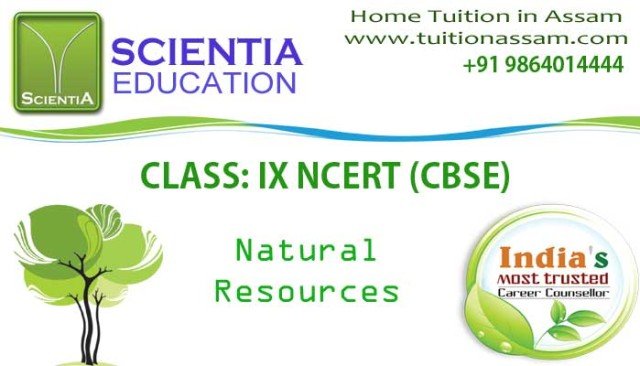
CLASS: IX NCERT (CBSE)
Natural Resources
SUMMARY
The important natural resources available on Earth are land, water and air.
The region of Earth where the atmosphere, hydrosphere and lithosphere interact and support life is called biosphere.
Living organisms constitute the biotic component of the biosphere. Air, water and soil constitute the abiotic component of the biosphere.
Air is a mixture of gases like nitrogen, oxygen and carbon dioxide. Plants and animals use oxygen for respiration, carbon dioxide is used by plants for photosynthesis are the uses of air.
Experiment -role of air in climate control: concludes that soil gets colder faster than water and air.
Why is the land near water bodies cool?
During the day, heated air above the land causes air to move from the sea to the land and making the land near water bodies colder.
The important natural resources available on Earth are land, water and air. The region of Earth where the atmosphere, hydrosphere and lithosphere interact and support life is called biosphere.
Living organisms constitute the biotic component of the biosphere. Air, water and soil constitute the abiotic component of the biosphere. Air is a mixture of gases like nitrogen, oxygen and carbon dioxide.
Plants and animals use oxygen for respiration, carbon dioxide is used by plants for photosynthesis are the uses of air. Experiment -role of air in climate control: concludes that soil gets colder faster than water and air.
Why is the land near water bodies cool?
During the day, heated air above the land causes air to move from the sea to the land and making the land near water bodies colder.
Cycling of chemicals between biological and geological world is called biogeochemical cycle. Four biogeochemical cycles includes water cycle, nitrogen cycle, carbon cycle and oxygen cycle.
Water enters the atmosphere as water vapour by evaporation. Water from plants evaporates as vapour into the atmosphere through transpiration. Water vapour in the atmosphere form clouds, called condensation.
Clouds break into rain, snow or fog, called precipitation. Photosynthesis with respect to carbon cycle: Plant use sunlight, carbon dioxide in the atmosphere to form carbohydrates.
Respiration with respect to carbon cycle: Plants and animals breakdown carbohydrates for energy and release of carbon dioxide.
Decomposition with respect to carbon cycle: Bacteria and fungi decay dead plants and animals releasing carbon dioxide.
Combustion with respect to carbon cycle: Burning of fossil feuls release carbon dioxide into the atmosphere.
Types of nitrogen fixation include both biological nitrogen fixation and physical nitrogen fixation.
Bacteria in the soil decompose the organic matter into ammonia, called ammonification.
Bacteria in the soil convert ammonia to nitrate, called nitrification. Denitrifying bacteria convert nitrite and nitrate to nitrogen, called denitrification.
Respiration and Combustion with Respect to Oxygen Cycle:
Plants and animals use atmospheric oxygen during respiration and oxygen is used for burning of fossil fuels.
Temperature inside a glass house is much higher than the surroundings, such enclosures are called greenhouse. Carbon dioxide trap the heat and thereby increase the temperature on earth, called the greenhouse effect.
Ozone absorbs harmful ultraviolet radiations from the Sun. ozone layer is depleting due to an increase in chlorofluorocarbons.














